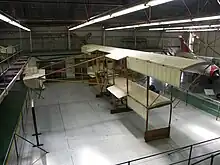| Paterson Biplane | |
|---|---|
| Role | Experimental biplane |
| National origin | United Kingdom |
| Designer | Cecil Compton Paterson |
| First flight | 14 May 1910 |
| Number built | 2 |
The Paterson Biplane was an early British biplane designed by Cecil Compton Paterson and built at the Liverpool Motor House, where Paterson was a director.[1] It was later called the Paterson No. 1 Biplane to distinguish it from subsequent aircraft designed by Paterson.
Design and development
Built between 1909 and 1910, the Paterson Biplane was a similar design to the Curtiss Biplane. It was an open-framed pusher biplane with a main frame made from bamboo and a tubular steel tricycle landing gear. It had a biplane front elevator and a single rear elevator with a rudder. It first flew from the beach at Freshfield north of Liverpool on 14 May 1910.[1] It flew a second time on 23 June 1910 but was damaged: after repair it was used by Paterson to obtain his aviator's certificate which was issued in December 1910. He built a second Biplane with a larger engine for Gerald Higginbotham, later called Biplane No. 2. This was completed in January 1911 . Both aircraft were based at Freshfield.[2]
Variants

Specifications (No. 1)
General characteristics
- Crew: 1
- Length: 31 ft 0 in (9.45 m)
- Wingspan: 34 ft 4 in (10.47 m)
- Powerplant: 1 × Anzani three-cylinder air-cooled piston engine , 30 hp (22 kW)
References
Notes
- 1 2 3 "Mr. C.C. Paterson's Biplane". Flight: 407. 28 May 1910. Retrieved 6 September 2011.
- 1 2 "A New British Biplane". Flight: 407. 28 February 1911. Retrieved 6 September 2011.